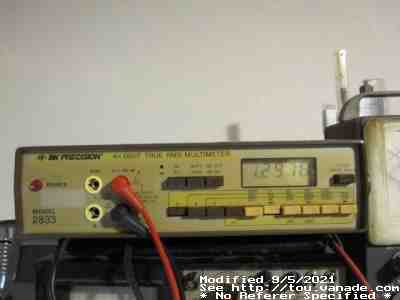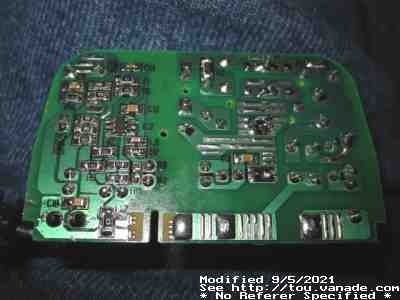The B+K Precision Model 2833 4½ digit True RMS multimeter
My B+K Precision Model 2833 Digital Multimeter on top of my VuData scope and
next to my Heathkit V7A VTVM

I got this specimen from a hamfest for the heck of it, as this is my first
4½ digit (19999 count) multimeter as well as my first true RMS meter.
Unfortunately my multimeter collection keeps
unnecessarily growing...
This looks like an early 80s LCD model which has many
resemblances to my Viz meter.
This meter supports DC/AC, has a (SLOW) continuity beeper, and dB mode.
The usual volts/amps/ohms/Hz are there too.
| Power Source | 6 x C-sized Alkaline, approx 1000 hours. External 7.5VDC 100mA, barrel positive |
|---|
| Type | Integrating, Intersil ICL7129 |
|---|
| Input Impedence | 11MΩ in 20V range |
|---|
| Display | 4½ digit LCD multiplexed
approx 2 readings per second |
|---|
| AC/DC V ranges | 200.00mV 2.0000V 20.000V 200.00V 1000.0V |
|---|
| AC/DC A ranges | 200.00µA 2.0000mA 20.000mA 200.00mA 2000.0mA and 20.000A |
|---|
| Resistance | 200.00Ω 2.0000KΩ(D) 20.000KΩ 200.00KΩ(D) 2000.0KΩ 20.000MΩ(D)
Continuity mode with beeper that can be disabled(!)
- (D) indicates Diode modes |
|---|
| Frequency | 20.000KHz 200.00KHz |
|---|
| dB | Decibels using true RMS |
|---|
A button is also available to hold the changing meter.
Power
This device uses 6 UM2 "C" sized batteries. I measured the current to be
around 5-6mA. A full capacity C cell holds 8Ah (Alkaline), 3.8Ah (C-Zn),
or 5Ah (NiMH), meaning this should last around 1300 hours on a set of alkaline
batteries, which is kind of pitiful as a set of 6 C cells isn't cheap.
The C-Zn will last even fewer at around 600 hours, but typical ICL7106 meters
will do 200 hours on a single PP3 (and you can get two per pack)
but you need to buy at least two packs of
C cells off the bat to fill this meter.
A 7.5V coaxial DC power input is on the back to power externally.
It appears the
DC input will cut off the battery and will not charge like the Viz.
First impressions of my BKP Model 2833
Well, the continuity check was a disappointment as well as
battery consumption. Also the Hold button will "hold" the screen when you first
power on, making it look like things aren't working. There are four shrouded
banana jacks that accept inputs. The 20A and 2A banana jacks are white in
color, which at least is some visual indication they're different than the
usual red/black.
I got the device with a pair of Fluke test probes, which seem pretty good, and
one reason I sprung for the cash. Alas the batteries was a bit of an
letdown but I knew about that ahead of time, hoping I can use the external
power jack. Even if I get 6 "heavy duty" C cells from Dollar Tree, it will cost
$2 for a set. $2 will get four PP3 for my Fluke which will last it 4000-8000
hours! Even my Tenma and other "200" hour meters, they will get 800 hours ($2
buys 4 Mn-Zn batteries) which still exceeds the 600 hours.
I suppose that's what you get for old ICL7129 meters...
External AC power
Well, what if I don't want to use batteries? So time to take advantage of
the power port, that none of my other meters have (except for the Viz that can
take 120VAC directly). So, I found an LG 5.1V 700mA switching power brick
from a phone which is gone. I picked this one as it could be opened without
destroying the case, and also it was a class IV.
I cut off the old connector which probably was for some phone and attached
a 5.5x2.5 coaxial, positive barrel, negative tip as it says on the back of
the unit.
However the voltage is a bit too low, 5.1 volts is well below the voltage needed
to power the ICL7129 - 7.5 volts is needed.
So I hacked it to 8.5V by opening the power brick (which is conveniently
openable by removing two screws) and swapping R11, the 12KΩ
surface mount resistor (marked "123") to 22KΩ (marked "223").
In the following photo, R11 is the surface mount resistor
to the upper left of the "R11" text, which is just to the upper left of the
circuit board notch along the bottom of the board.
Yes I had to use batteries to test this hack
(used the meter to test its own future PSU though I could have used
one of my others in the "collection"), so far so good.

Note that the 7.5V that it says on the back is for an unregulated supply, which
tends to peak above 9V. The PSU must be around but must not exceed that of a
typical set of alkaline cells, especially when new. Since a new C cell can be
up to 1.55-1.6 volts, the PSU must never exceed 9.6V. However on the low end
7.5V is 1.25V/cell, which BKP probably chose to match that of NiCd cells.
Alkaline cells can be lower, probably 1.1V/cell before they're dead, so likely
something less than 7V will trigger the low battery indicator and then stop
working. I'll need to test this at some point.
I guesstimated that I needed a 20KΩ resistor but couldn't find one,
but 22KΩ I did have. 8.5V is well within the voltage of the power
pack and thus it was chosen. I should also replace
the two 220µF caps on the output which are rated for 10V but didn't for
the time being... And of course the 700mA is well overkill for the typically
less than 10mA the meter uses. Perhaps I should add some LEDs to backlight
the LCD...
Now I can leave this multimeter on anytime just like the Viz. Not only that,
my Kill-A-Watt doesn't even detect the power consumption of the meter at all,
it remains at 0.0 watts.
Calibration
I measured my 12V SLA battery to see how badly calibrated it is:
| BK Precision 2833 | 12.584 | Stable |
|---|
| Fluke 77 | 12.57 | Stable |
|---|
| Tek DM502 | 12.58 | 12.57 cold, flickers between 12.58 and 12.59 after warming up |
|---|
| CenTech P98674 | 12.63 | Stable |
|---|
I guess I can say that this meter should be about right though like the Fluke
and Tek they've not been calibrated for a long time, and the Mastech/CenTech is
way off.